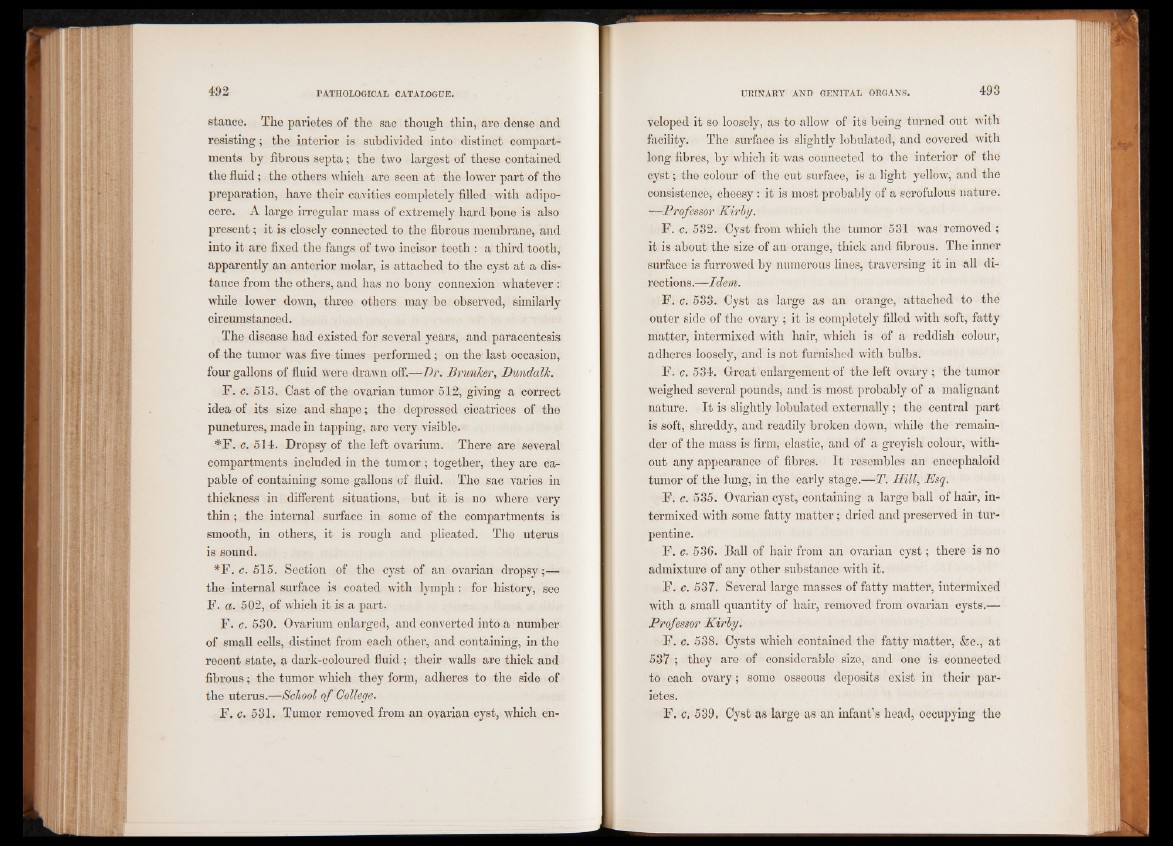
stance. The parietes of the sac though thin, are dense and
resisting; the interior is subdivided into distinct compartments
by fibrous septa; the two largest of these contained
the fluid; the others which are seen at the lower part of the
preparation, have their cavities completely filled with adipo-
cere. A large irregular mass of extremely hard bone is also
present; it is closely connected to the fibrous membrane, and
into it are fixed the fangs of two incisor teeth : a third tooth,
apparently an anterior molar, is attached to the cyst at a distance
from the others, and has no bony connexion whatever :
while lower down, three others may be observed, similarly
circumstanced.
The disease had existed for several years, and paracentesis
of the tumor was five times performed; on the last occasion,
four gallons of fluid were drawn off.—Dr. Brunker, Dundalk.
F. c. 513. Cast of the ovarian tumor 512, giving a correct
idea of its size and shape; the depressed cicatrices of the
punctures, made in tapping, are very visible.
#F. c. 514. Dropsy of the left ovarium. There are several
compartments included in the tumor ; together, they are capable
of containing some gallons of fluid. The sac varies in
thickness in different situations, but it is no where very
thin; the intei’nal surface in some of the compartments is
smooth, in others, it is rough and plicated. The uterus
is sound.
*F. c. 515. Section of the cyst of an ovarian dropsy;—
the internal surface is coated with lymph : for history, see
F. a. 502, of which it is a part.
F. c. 530. Ovarium enlarged, and converted into a number
of small cells, distinct from each other, and containing, in the
recent state, a dark-coloured fluid ; their walls are thick and
fibrous; the tumor which they form, adheres to the side of
the uterus.—School of College.
F. c. 531. Tumor removed from an ovarian cyst, which enveloped
it so loosely, as to allow of its being turned out with
facility. The surface is slightly lobulated, and covered with
long fibres, by which it was connected to the interior of the
cyst; the colour of the cut surface, is a light yellow, and the
consistence, cheesy : it is most probably of a scrofulous nature.
—Professor Kirby.
F. c. 532. Cyst from which the tumor 531 was removed ;
it is about the size of an orange, thick and fibrous. The inner
surface is furrowed by numerous lines, traversing it in all directions.—
Idem.
F. c. 533. Cyst as large as an orange, attached to the
outer side of the ovary; it is completely filled with soft, fatty
matter, intermixed with hair, which is of a reddish colour,
adheres loosely, and is not furnished with bulbs.
F. c. 534. Great enlargement of the left ovary ; the tumor
weighed several pounds, and is most probably of a malignant
nature. It is slightly lobulated externally ; the central part
is soft, shreddy, and readily broken down, while the remainder
of the mass is firm, elastic, and of a greyish colour, without
any appearance of fibres. It resembles an encephaloid
tumor of the lung, in the early stage.—T. Hill, Esq.
F. c. 535. Ovarian cyst, containing a large ball of hair, intermixed
with some fatty matter; dried and preserved in turpentine.
F. c. 536. Ball of hair from an ovarian cyst; there is no
admixture of any other substance with it.
F. c. 537. Several large masses of fatty matter, intermixed
with a small quantity of hair, removed from ovarian cysts.—
Professor Kirby.
F. c. 538. Cysts which contained the fatty matter, &c., at
537 ; they are of considerable size, and one is connected
to each ovary; some osseous deposits exist in their parietes.
F. c, 539. Cyst as large as an infant’s head, occupying the